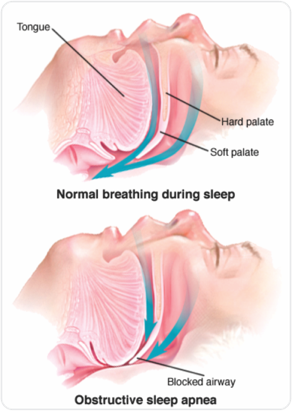SLEEP APNEA
Obstructive Sleep Apnea
Obstructive Sleep Apnea (OSA) is a contributing factor to low levels of oxygen in the brain, and cardiovascular, cerebral, and metabolic problems.
Patients with moderate to severe (OSA) are three times more likely to have a stroke.

(OSA) reduces the production of the hormone leptin, which is involved with the body’s appetite and the regulation of body weight, of which there is a propensity for obesity.
There is a predisposition towards diabetes as a result of the body’s production of high levels of the hormone cortisol. High levels of cortisol can contribute to the body’s resistance to insulin and glucose intolerance.
• Gasping, irregular or stopped breathing during sleep
• Hypertension high blood pressure
• Diabetes
• Morning headaches
• Extreme daytime sleepiness
• Memory deficit
• Depression
• Night-time reflux/heartburn/GERD
• Nocturia
• Genetics
• Gender (more common in men)
• Large neck (>15.7″women, >16.9″men)
• Obesity (BMI.30)
• Diagnosis of hypertension
• Excessive use of alcohol, sedatives, and tobacco
Problem snoring, in which the tongue is completely sucked against the back of the throat and blocks breathing, can pose serious health risks.
• Hypertension/high blood pressure
• Strokes
• Cardiovascular disorders
• Diabetes
• Obesity
• Dementia
• Depression
• Reflux/heartburn/GERD
• Nocturia
• Insomnia
• Nocturnal asthma/COPD
• Impotence
Snoring is caused by a narrowing of the upper airway during sleep. This can be due to large tonsils, a long uvula or excessive flabby tissue in the throat.
However, the most common cause of narrowing of the upper airway is a tongue muscle that becomes too relaxed during sleep. When relaxed, the muscle is sucked into the back of the throat with each breath taken.
Snoring occurs when air travels faster through a narrow tube than through a board one. This rapidly moving air causes the relaxed soft tissues of the throat (tonsils, soft palate, Uvula or excessive flabby tissue) to vibrate. It is this vibration that creates the sound of snoring.
Sixty percent of men and 40 percent of women between the ages of 41 and 65 are habitual snores. Snoring increases greatly once people reach the age of 35.
Young T. Peppard PE, Gottlieb D.J. Epidemiology of Obstructive sleep apnea: a population health perspective. Am J respire Crit care Med 2002.
Snoring is common in children aged 2 to 7, particularly at times of upper respiratory tract infection when the tonsils enlarged.
Ali NJ, Pitson D, Stradling JR. Natural history of snoring and related behavior problems between the ages of 4 and 7 years. Arch Dis Child 1994.
Women in the third trimester of pregnancy commonly experience problem snoring.
Santiago JR, Nolledo MS, W, Santiago TV. Sleep and sleep disorders in pregnancy, Ann Intern Med 2001.
